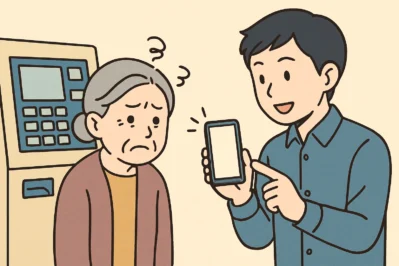K-Tech Talk: Proposing Solutions for Korea’s Digital Divide
Hello! Welcome to Maeil Hangeul, the place to upgrade your Korean skills to the next level!
Today, we’re tackling a sophisticated and highly relevant topic: proposing solutions to the digital divide. This is perfect for when you want to participate in professional meetings, academic discussions, or simply understand Korean news on a deeper level. You might be thinking, “Korea is a tech paradise, right?” You’re not wrong! But this rapid digital transformation has also created a significant challenge. Nowadays in Korea, there’s a growing conversation about the “digital divide” (디지털 격차), where certain groups, like the elderly, struggle to keep up. Let’s learn the advanced Korean you need to be part of this important discussion!
Core Expressions for Your Professional Toolkit
Here are some key phrases that will make you sound like a policy expert.
1. 정보 격차를 해소하다 (jeongbo gyeokchareul haesohada)
* Pronunciation: [jeong-bo gyeok-cha-reul hae-so-ha-da]
* English Meaning: To resolve/bridge the information gap.
* Detailed Explanation: This is a formal and powerful phrase used in reports, news, and official proposals. 정보 (jeongbo) means “information,” 격차 (gyeokcha) means “gap” or “disparity,” and 해소하다 (haesohada) is a high-level verb meaning “to resolve” or “to dissolve.” It’s the go-to expression when formally discussing solutions to digital inequality.
2. ~는 방안을 강구해야 합니다 (~neun bang-aneul gang-gu-hae-ya ham-ni-da)
* Pronunciation: [~neun bang-a-neul gang-gu-hae-ya ham-ni-da]
* English Meaning: We must devise/seek a plan to…
* Detailed Explanation: This is a very formal and persuasive grammar pattern used for making strong proposals. 방안 (bangan) is a sophisticated word for “plan” or “measure,” and 강구하다 (gang-gu-hada) means “to devise” or “to seek out.” Use this at the end of a sentence to strongly advocate for a course of action in a presentation or formal document.
* Example: 노인들을 위한 교육 프로그램을 만드는 방안을 강구해야 합니다. (We must devise a plan to create educational programs for the elderly.)
3. 사회적 취약 계층 (sahoejeok chwiyak gyecheung)
* Pronunciation: [sa-hoe-jeok chwi-yak gye-cheung]
* English Meaning: Socially vulnerable groups/classes.
* Detailed Explanation: This is a key term in sociology and policy-making. It refers to groups that are more susceptible to social problems, such as the elderly, low-income families, or people with disabilities. 사회적 (sahoejeok) means “social,” 취약 (chwiyak) means “vulnerable,” and 계층 (gyecheung) means “class” or “stratum.” Using this term shows a deep understanding of the social context.
4. 맞춤형 교육을 제공하다 (matchumhyeong gyoyugeul jegonghada)
* Pronunciation: [mat-chum-hyeong gyo-yu-geul je-gong-ha-da]
* English Meaning: To provide customized/tailored education.
* Detailed Explanation: This is a fantastic solution-oriented phrase. The prefix 맞춤형 (matchumhyeong) means “tailored” or “customized” and is extremely common in modern business and policy Korean. 제공하다 (jegonghada) is the formal verb for “to provide.” This phrase suggests a thoughtful, non-generic approach to solving a problem.
Example Dialogue
Let’s see how these expressions work in a professional setting. Here, two colleagues, Min-jun (A) and Ji-hye (B), are brainstorming for a corporate social responsibility (CSR) proposal.
A (민준): 다음 사회 공헌 활동은 중요한 사회 문제에 초점을 맞췄으면 합니다.
(For our next CSR activity, I hope we can focus on an important social issue.)
B (지혜): 동의해요. 최근 코로나19 이후로 디지털 정보 격차가 더욱 심화되고 있어요. 특히 노년층이 어려움을 겪고 있죠.
(I agree. The digital information gap has worsened since COVID-19. The elderly population, in particular, is facing difficulties.)
A (민준): 맞습니다. 우리는 사회적 취약 계층의 정보 격차를 해소하는 방안을 강구해야 합니다.
(That’s right. We must devise a plan to resolve the information gap for socially vulnerable groups.)
B (지혜): 지역 사회 노인분들을 대상으로 맞춤형 디지털 교육을 제공하는 프로젝트는 어떨까요? 예를 들어, 키오스크 사용법이나 스마트폰 뱅킹 같은 것들이요.
(How about a project that provides customized digital education for seniors in our local community? For example, how to use kiosks or smartphone banking.)
A (민준): 아주 좋은 생각입니다. 구체적인 실행 계획을 세워 바로 보고합시다.
(That’s an excellent idea. Let’s create a detailed action plan and report it immediately.)
Culture Tip & Trend Deep Dive
In Korea, the “digital divide” isn’t just an abstract concept—it’s a daily reality. A huge topic of discussion is the proliferation of unmanned kiosks (키오스크) in places like cafes, fast-food restaurants, and even government offices. Many news reports have highlighted the frustration of elderly citizens who struggle to place a simple order.
This is why “digital literacy” (디지털 리터러시 or 디지털 문해력) has become a major buzzword. The Korean government and local community centers (주민센터) are actively creating programs to tackle this. So, when you propose providing 맞춤형 교육 (matchumhyeong gyoyuk), you’re tapping into a very real and current solution being implemented across the country. Mentioning the kiosk issue in your discussion will show that you have a nuanced understanding of modern Korean society.
Let’s Review and Practice!
Great job today! We’ve learned some high-level vocabulary and grammar to discuss the digital divide like a pro. We covered:
* 정보 격차를 해소하다 (to resolve the information gap)
* ~는 방안을 강구해야 합니다 (we must devise a plan to…)
* 사회적 취약 계층 (socially vulnerable groups)
* 맞춤형 교육을 제공하다 (to provide customized education)
Now, let’s put it into practice!
1. Fill in the blank:
정부는 ( _______ )이 디지털 사회에서 소외되지 않도록 지원 정책을 마련해야 합니다.
(The government must prepare support policies so that ( _______ ) are not alienated in the digital society.)
2. Sentence Building:
Using the grammar pattern ~는 방안을 강구해야 합니다, write one sentence proposing a solution to a problem in your community or country.
We’d love to see your answers! Leave a comment below using the expressions you learned today. Keep up the fantastic work






